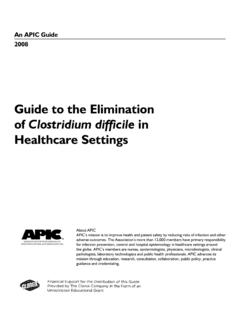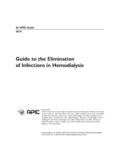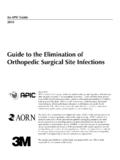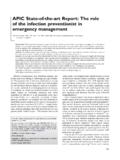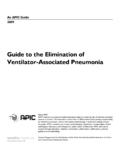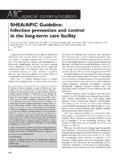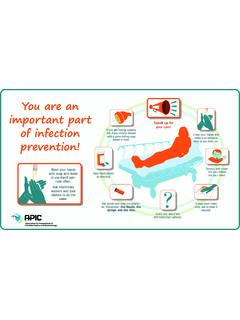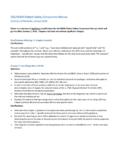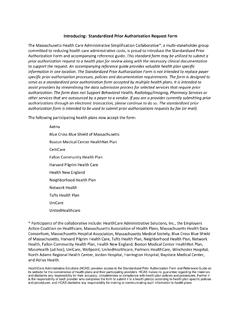Transcription of Guide to Preventing - apic.org
1 apic Implementation GuideGuide to Preventing Clostridium difficile InfectionsAbout APICAPIC s mission is to create a safer world through prevention of infection. The association s more than 14,000 members direct infection prevention programs that save lives and improve the bottom line for hospitals and other healthcare facilities. apic advances its mission through patient safety, implementation science, competencies and certification, advocacy, and data the SponsorClorox healthcare believes that patient care and safety are the cornerstones of infection prevention, and is committed to supporting education that helps advance the professional development of Infection Preventionists and reduce healthcare -associated infections, particularly Clostridium difficile.
2 As a long-standing apic Strategic Partner, Clorox healthcare is honored to fund this C. difficile Implementation Guide and congratulates apic , the authors, and all who were involved in creating a Guide that will serve as a free resource to the infection prevention community, with the goal of someday eradicating C. the Implementation Guide seriesAPIC Implementation Guides help infection preventionists apply current scientific knowledge and best practices to achieve targeted outcomes and enhance patient safety. This series reflects apic s commitment to implementation science and focus on the utilization of infection prevention research. Topic-specific information is presented in an easy-to-understand-and-use format that includes numerous examples and tools.
3 Visit to learn more and to access all of the titles in the Implementation Guide 2013 by the Association for Professionals in Infection Control and Epidemiology, Inc. ( apic )All rights reserved. No part of this publication may be reproduced, stored in a retrieval system, or transmitted in any form or by any means, electronic, mechanical, photocopied, recorded, or otherwise, without prior written permission of the publisher. Printed in the United States of AmericaFirst edition, February 2013 ISBN: 1-933013-54-0 All inquiries about this Guide or other apic products and services may be directed addressed to:APIC1275 K Street NW, Suite 1000 Washington, DC 20005 Phone: 202-789-1890 Fax: 202-789-1899 Email: provides information and services as a benefit to both apic members and the general public.
4 The material presented in this Guide has been prepared in accordance with generally recognized infection prevention principles and practices and is for general information only. The Guide and the information and materials contained therein are provided AS IS , and apic makes no representation or warranty of any kind, whether express or implied, including but not limited to, warranties of merchantability, noninfringement, or fitness, or concerning the accuracy, completeness, suitability, or utility of any information, apparatus, product, or process discussed in this resource, and assumes no liability to Preventing Clostridium difficile InfectionsAssociation for Professionals in Infection Control and Epidemiology 3 Table of ContentsAcknowledgments.
5 4 Declarations of Conflicts of Interest ..7 Introduction ..8 Section 1: Pathogenesis and Changing Epidemiology of Clostridium difficile Infection (CDI) ..9 Section 2: Diagnosis ..15 Section 3: Modes of Transmission ..22 Section 4: Surveillance ..24 Section 5: Focusing on Prevention: Hand Hygiene ..32 Section 6: Focusing on Prevention: Contact/Isolation Precautions ..37 Section 7: Focusing on Prevention: Environmental Infection Prevention ..50 Section 8: Special Considerations in Skilled Nursing Facilities ..67 Section 9: CDI in Special Populations ..69 Section 10: Antimicrobial Stewardship and Clostridium difficile Infection: A Primer for the Infection Preventionist ..73 Section 11: Fecal Bacteriotherapy ..81 Section 12: Glossary of Terms.
6 87 Section 13: Frequently Asked Questions ..90 Appendix: Preventing the Transmission of Clostridium difficile in healthcare Settings ..97 Guide to Preventing Clostridium difficile Infections4 Association for Professionals in Infection Control and EpidemiologyAcknowledgmentsAccomplishing this comprehensive update required input and expertise from a broad array of experts from practice and research settings. The Association for Professionals in Infection Control and Epidemiology acknowledges the valuable contributions from the following individuals:Lead authorRuth M. Carrico, PhD, RN, FSHEA, CICU niversity of LouisvilleSchool of Public HealthLouisville, KentuckyContributorsKris Bryant, MDDepartment of Pediatric Infectious DiseaseUniversity of LouisvilleSchool of MedicineLouisville, KentuckyFernanda Lessa, MD, MPHC enters for Disease Control and PreventionAtlanta, GeorgiaBrandi Limbago, PhDCenters for Disease Control and PreventionAtlanta, GeorgiaLoretta Litz Fauerbach, MS, CICS hands HospitalUniversity of FloridaGainesville, FloridaJames F.
7 Marx, RN, MS, CICB road Street SolutionsSan Diego, CaliforniaGuide to Preventing Clostridium difficile InfectionsAssociation for Professionals in Infection Control and Epidemiology 5 Fontaine Sands, DrPH, MSN, CICE astern Kentucky UniversityCollege of Health SciencesRichmond, KentuckyDana Stephens, RN, CICS aint Joseph Health SystemLexington, KentuckyKelly Westhusing, MPH, CPHU niversity of LouisvilleSchool of MedicineLouisville, KentuckyTimothy Wiemken, PhD, MPH, CICU niversity of LouisvilleSchool of Public HealthLouisville, KentuckyReviewersBarbara DeBaun, RN, MSN, CICI mprovement AdvisorCynosure HealthSan Francisco, California Sherrie Dornberger, RNC, GDCN, CDP, CDONA, FACDONAE xecutive DirectorThe National Association Directors of Nursing Administration in Long Term CareCincinnati, OhioChristina Franic, RN, BSN, ICP, MSc, MBACHICA CanadaVancouver Island Health AuthorityNanaimo, British Columbia, CanadaCandace Friedman, MPH, CICU niversity of MichiganHospitals and Health CentersAnn Arbor, MichiganCindy Friis, MEd, BSN, RN-BCSmith Bucklin of Gastroenterology Nurses and Associates, , IllinoisAnn Herrin, BSN, RN, CGRNV eterans Administration Health Care SystemSociety of Gastroenterology Nurses and Associates, Diego, CaliforniaPhenelle Segal, RN, CICP residentInfection Control Consulting ServicesDelray Beach, Florida Production TeamManaging EditorThomas WeaverDirector.
8 Professional PracticeAssociation for Professionals in Infection Control and Epidemiology, Management and Production OversightAnna CongerSr. Manager, Practice ResourcesAssociation for Professionals in Infection Control and Epidemiology, Meredith BechtleMaryland CompositionCover DesignSarah VickersArt DirectorAssociation for Professionals in Infection Control and Epidemiology, to Preventing Clostridium difficile Infections6 Association for Professionals in Infection Control and EpidemiologyGuide to Preventing Clostridium difficile InfectionsAssociation for Professionals in Infection Control and Epidemiology 7 Declarations of Conflicts of InterestRuth M. Carrico, PhD, RN, FSHEA, CIC Has nothing to Bryant, MD Has acted as principal investigator on clinical trials funded by GSK, Novartis, Pfizer, and DeBaun, RN, MSN, CIC Has nothing to Dornberger, RNC, GDCN, CDP, CDONA, FACDONA Has nothing to Franic, RN, BSN, ICP, MSc, MBA Has nothing to Friedman, MPH, CIC Has nothing to Friis, MEd, BSN, RN-BC Has nothing to Herrin, BSN, RN, CGRN Has nothing to Lessa, MD, MPH Has nothing to Limbago, PhD Has nothing to Litz Fauerbach, MS, CIC Has nothing to F.
9 Marx, RN, MS, CIC Has nothing to Sands, DrPH, MSN, CIC Has nothing to Segal, RN, CIC Has nothing to Stephens, RN, CIC Has nothing to Westhusing, MPH, CPH Has nothing to Wiemken, PhD, MPH, CIC Received two grants from Clorox Corporation to act as an investigator for activity of a hypochlorite-based environmental cleaner against C. Clostridium difficile transmission and infection continues to represent a serious and difficult challenge in infection prevention and patient safety. The average total cost for a single inpatient C. difficile infection (CDI) is more than $35,000, and the estimated annual cost burden for the healthcare system exceeds $3 The epidemiology of this infection is changing, and its presence in healthcare settings as well as the community has caused personnel across the entire healthcare continuum to re-evaluate approaches and perspectives.
10 Acknowledging this, the Department of Health and Human Services (HHS) convened the Federal Steering Committee for the Prevention of healthcare -Associated Infections. Members of the steering committee include clinicians, scientists, and public health leaders. In April 2012, the steering committee, along with scientists and program officials across HHS, released the National Action Plan to Prevent healthcare -Associated Infections: Roadmap to Elimination,2 a healthcare -associated infection (HAI) action plan providing a roadmap for Preventing HAIs in acute care hospitals, ambulatory surgical centers, and other facilities. In the first phase, the HAI action plan focused on acute care hospitals where the scientific information on prevention and the capacity to measure improvement was most complete and where the associated morbidity and mortality was greatest.
